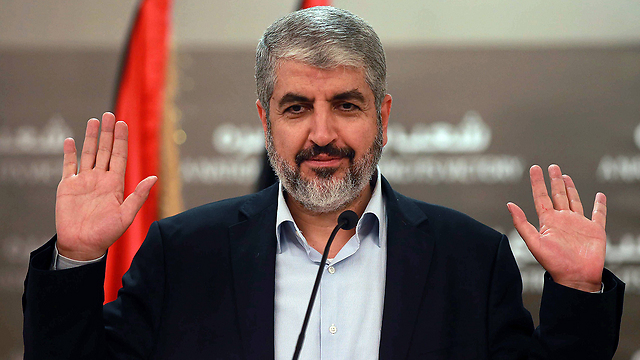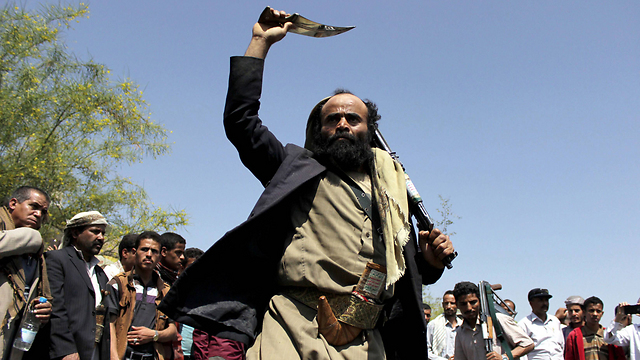Ticking time bombs: Hezbollah in Gaza and Palestinians in Syria
Analysis: Hamas betrayed Iran over Syria and then Yemen, finding a new patron in Qatar, but Iran will not give up control so easily, and has now anointed who it hopes will be Gaza's new rulers, and they are even more violent and dangerous.
Hamas shifting alliance between Iran and Qatar has undoubtedly harmed the terror group. Hamas's declining power is good news in and of itself, but it is also dangerous, as it creates two ticking time bombs as far as Israel is concerned.
First, in Israel's north – in the form of the Palestinian refugee camp of Yarmouk in Syria – and the second in Gaza, where Iran's new Hezbollah-like proxy is setting up shop. How did this happen and what are the ramifications for Israel?
New catastrophe
Many Palestinians have begun to use the phrase "second nakba" to describe the recent events in Yarmouk, the Palestinian refugee camp on the outskirts of Damascus that has recently sufferede an Islamic State offensive. It was a "catastrophe" equal to Israel's establishment in 1948.
Yarmouk is the largest such refugee camp in Syria, and until four years ago was home to more than 150,000 people, living in poverty in its densely populated narrow and winding streets. The population now numbers around 20,000. When the Syrian civil war started more than four years ago, the Palestinians adopted a policy of neutrality, at least until opposition forces descended on the strategically located camp in 2012, and it quickly deteriorated into a battlefield between rebels and regime forces.
In the collective Palestinian memory, Black September is a massacre that took place during a 1970 attempt to topple the king of Jordan. Many now call September 2013 "Black September 2", when the Syrian army retreated from the camp, all ties with the regime were lost, along with Yarmouk's waer and electricty connections. Within two months, the camp had denegrated into ruins, a hell on earth, with bodies in the streets and almost no local government, not even enough to clear the bodies.
Local Palestinians witnessed daily battles between Assad's forces and different rebel factions, themselves mired in violent infighting. Regime shelling and barrel bomb attacks became routine. The ongoing siege created a humanitarian disaster of epic proportions, with food and medicine scarce. Refugees who fled the camp attested to the dire situation, describing widespread hunger and illness among those who remained. They said residents had been forced to slaughter dogs, cats and donkeys, and boil grass for food. Who is to blame for this situation?
Hamas' flip-flop
In December 2012, while on a visit to Gaza, Hamas' political leader, Khalad Mashaal, announced that the group was supporting Syrian rebels in their fight to oust President Bashar Assad. His announcement created a schism between Hamas and its main economic and military supporters in recent years – Syria and Hezbollah.
At the time, turning their back on their biggest allies seemed like a smart bet and the right thing to do. Assad was losing control over Syria and his fate seemed sealed; and in Egypt, the Muslim Brotherhood, Hamas' sister organization, had taken control. A year later things looked very different: Assad suddenly seemed to have regained the upper hand and the Brotherhood was violently ousted from power by Egypt's now president and then military chief Fatteh Abed al-Sisi.
Hamas suddenly found itself without a patron. It has since been dealt a further blow in the shape of the heavy losses it suffered during the conflict with Israel in Operation Protective Edge. The "mukama" axis – the axis of "resistance" comprising Iran, Syria and Hezbollah – fell apart, and with it went the money and the weapons. In retribution for its betrayal, Mashaal was thrown out of Damascus and he moved Hamas' political bureau to Qatar.
When the war in Yemen broke out, with a coalition led by Saudi Arabia fighting against the Iran-supported Shiite Houthi rebels, Mashaal said Hamas supported the Saudi fight against the rebels. After all, the coalition includes Qatar - a major donor of funds to rebuild Gaza after the war with Israel.
The statement by Mashaal was yet another slap in the face to Iran, which has thrown its might behind the rebels. The move further strained ties and buried any chance for reconciliation between Iran and Hamas in the near future, leaving Hamas still hungry for money and arms.
The decision also strained relations within Hamas. Some of the Gaza leadership, headed by Mahmoud Zahar, recently said Mashaal's statements do not represent those of the entire organization. Mashaal's flip-flop has further entangled the group in the Syrian conflict – and the price will be paid, both in Gaza and in Yarmouk.
Hezbollah in Gaza
Hamas' betrayal further widened the distrust and schism between Iran and Hamas, especially the part led by Mashaal. According to Arab media, Iran is fuming at Mashaal's statement on Yemen, and has vowed to cut funding for Gaza's rehabilitation. Hamas is still the strongest of all terror factions in the Strip, but the current crisis has already begun to take its toll on Gaza's de facto sovereigns.
There is unrest fomenting in the south and north of the Strip, with rise of new factions other than Islamic Jihad and its ilk. In Rafah in the south, salafists supporting al-Qaeda are helping terrorists cross from Sinai via tunnels. In the north, a group call "Hezbollah in Gaza" has reappeared. The group, Harakat as-Sabeereen Natzran Le-Palastin (“The Patient Ones' Movement for the Liberation of Palestine”), which sometimes goes by the acronym of Hesn (“fortification”). Their flag is almost a mirror image of the Hezbollah banner, with the small addition of a map of greater Palestine.
Despite its attempt to deny it, the group is affialted with a radical sect of Shiite Islam, unlike the majority of Gaza which is predominantly Sunni. Thus, it seems Iran has already selected its choice to replace Hamas. As much as Hesn grows, the pro-Shiite forces in northern Gaza will grow accordingly.
Politically, the new Hezbollah branch is opposed to any type of hudna (interim ceasefire) with Israel, and has been pressuring Hamas to renew its rocket fire on Israel. It has begun to amass arms, and its operatives claim to have fired a rocket at Israel during Operation Protective Edge. On its Facebook page, the group claimed a terror attack in the West Bank some two weeks ago, in which two soldiers IDF were stabbed.
The "Patient Ones" is claiming to be a popular movement, but is still significantly smaller than Hamas. But we would be wise to remember that 30 years ago, Hamas was also a small and almost completely unknown entity.
Dr. Yaron Friedman, Ynet's commentator on the Arab world, is a graduate of the Sorbonne. He teaches Arabic and lectures about Islam at the Technion, at Beit Hagefen and at the Galilee Academic College.





















